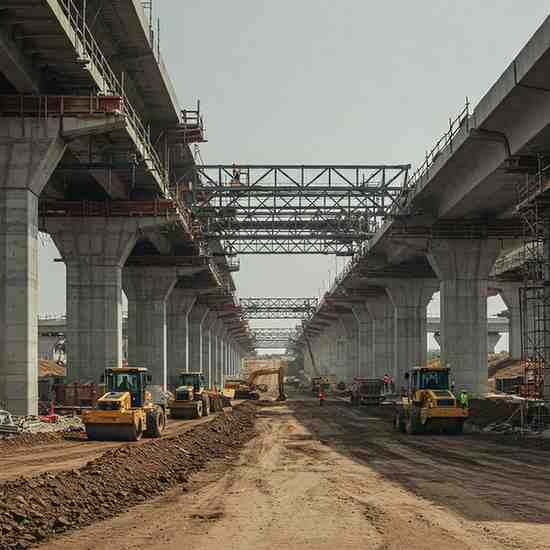
Beyond Construction: Exploring the Ripple Effect of Infrastructure Development on Related Sectors
Beyond Construction: Exploring the Ripple Effect of Infrastructure Development on Related Sectors
India is currently witnessing a transformative phase, marked by an unprecedented surge in infrastructure development. From sprawling highway networks and modern railway lines to burgeoning energy grids and smart city initiatives, the tangible impact of this boom is evident across the nation. While the immediate beneficiaries, construction companies and infrastructure developers, often capture investor attention, the influence of this growth narrative extends far beyond the obvious. This post delves into the intricate web of interconnected sectors that are significantly impacted by infrastructure development, offering valuable insights for retail investors, financial analysts tracking the Indian markets, and anyone keen on understanding the broader economic and investment landscape. By recognizing these ripple effects, investors can unlock a wider array of opportunities and strategically enhance their portfolio diversification.
Thank you for reading this post, don't forget to subscribe!The Foundational Pillars: Understanding Infrastructure and Construction
Infrastructure development in the Indian context encompasses the creation and enhancement of essential physical and organizational structures crucial for economic growth and societal well-being. Key areas include a robust transportation network comprising roads, railways, ports, and airports; a reliable energy sector encompassing power generation, transmission, and distribution; and essential utilities like water supply and sanitation systems. Construction stocks represent the frontline players in this development, actively involved in the physical building and supply of materials for these projects. Companies engaged in civil engineering, procurement, and construction (EPC), as well as those manufacturing essential materials like cement, steel, and construction equipment, form the core of this segment.
Analyzing Market Trends in India
The Indian infrastructure sector is currently riding a wave of government impetus, with significant budgetary allocations and policy initiatives like the National Infrastructure Pipeline (NIP) and PM Gati Shakti driving growth. This focus translates to a robust pipeline of projects across various sub-sectors. Simultaneously, the construction sector is experiencing heightened activity, fueled by these infrastructure projects alongside a growing demand for residential and commercial spaces. Current trends indicate a strong emphasis on sustainable and technologically advanced construction practices. However, challenges such as land acquisition delays, environmental clearances, and raw material price volatility remain pertinent factors to consider.
The Energy Sector: Powering Progress
The symbiotic relationship between infrastructure development and the energy sector is undeniable. Every new infrastructure project, be it a factory, a transportation corridor, or an expanding urban center, necessitates a corresponding increase in energy demand. This surge in consumption directly impacts energy stocks, encompassing companies involved in diverse facets of the energy value chain. This includes power generation companies, spanning both conventional sources like thermal power and the rapidly growing renewable energy sector (solar, wind, hydro). Furthermore, companies engaged in the transmission and distribution of electricity are crucial in ensuring that the generated power reaches its intended destinations.
Energy Sector Analysis in relation to Infrastructure Growth
Government policies promoting renewable energy adoption and investments in grid modernization are further shaping the energy sector’s trajectory in tandem with infrastructure expansion. The need to power new infrastructure sustainably creates significant opportunities for companies specializing in renewable energy technologies and efficient energy management solutions. Investors tracking the impact of infrastructure growth should closely monitor the performance of energy companies, particularly those aligned with India’s long-term energy goals.
Real Estate: Building the Future Landscape
Infrastructure development acts as a powerful catalyst for growth in the real estate sector. Improved connectivity through new roads, railways, and airports unlocks previously inaccessible areas, making them viable for residential, commercial, and industrial development. The appreciation of land values in regions witnessing infrastructure upgrades is a common phenomenon. Furthermore, the demand for various types of real estate – from affordable housing and premium residential projects to commercial spaces catering to businesses and industrial parks leveraging enhanced connectivity – witnesses a significant upswing.
Understanding the Interplay between Infrastructure Development and Real Estate Stocks
The development of industrial corridors and logistics parks, often a direct outcome of infrastructure investments, further fuels demand for industrial real estate. Similarly, the growth of urban centers, facilitated by better infrastructure, drives the need for commercial and retail spaces. Investors should analyze the performance of real estate developers with a focus on their land holdings and project pipelines in regions benefiting from ongoing and planned infrastructure projects.
The Supporting Industries: A Network of Beneficiaries
Beyond the direct beneficiaries, a vast network of supporting industries experiences a surge in demand due to infrastructure development. The cement and steel industries are prime examples, as these materials are fundamental to virtually all construction activities. Increased infrastructure spending directly translates to higher demand and potentially improved profitability for companies in these sectors. Similarly, logistics and transportation services play a crucial role in moving raw materials to construction sites and finished goods across the enhanced infrastructure network, creating opportunities for logistics companies, freight operators, and warehousing providers.
The financial services sector also benefits significantly, with increased demand for project financing, infrastructure bonds, and insurance services related to large-scale development projects. Furthermore, the integration of technology in infrastructure projects, including automation, project management software, and smart city solutions, opens up avenues for technology companies. By understanding these indirect linkages, investors can identify a broader spectrum of investment opportunities beyond core infrastructure and construction stocks.
Identifying Indirect Investment Opportunities beyond Core Infrastructure Stocks and Construction Stocks
Analyzing the growth prospects of companies involved in these supporting industries can provide valuable diversification benefits to an investment portfolio. These sectors often exhibit strong correlation with infrastructure spending but may also have their own independent growth drivers, offering a more nuanced exposure to the overall economic development narrative.
Navigating the Investment Landscape: Key Considerations
While the opportunities presented by the infrastructure ecosystem are compelling, it is crucial for investors to approach this landscape with diligence and a well-informed perspective. Thorough research into individual companies, their financial health, and their track record is paramount. When evaluating performance of construction and infrastructure stocks, investors should consider factors such as project execution capabilities, order books, and debt levels. Similarly, analyzing the performance of related energy stocks and real estate stocks requires understanding sector-specific dynamics, regulatory environments, and competitive landscapes.
Infrastructure Sector Analysis and Identifying Potential Investment Avenues
The role of government spending on infrastructure sector and evolving policy changes cannot be overstated. Investors need to stay abreast of government initiatives, budgetary allocations, and regulatory developments that can significantly impact the growth trajectory of these sectors. Understanding the potential risks associated with project delays, cost overruns, and policy shifts is equally important for making informed investment decisions.
Conclusion: Diversification through the Infrastructure Ecosystem
The ongoing infrastructure boom in India presents a wealth of investment opportunities that extend far beyond the conventional focus on construction and infrastructure stocks. By recognizing the intricate ripple effects across the energy, real estate, and various supporting industries, investors can gain a more comprehensive understanding of the investment landscape. Considering these interconnected sectors offers a strategic pathway to enhance portfolio diversification, aligning with the goals of building a resilient and potentially high-growth investment strategy. As India continues its journey of infrastructure-led development, the astute investor who looks beyond the immediate beneficiaries stands to capitalize on the broader economic transformation unfolding across the nation.
Related Blogs:
Best Steel Stocks in India in 2025
Top 5 Infrastructure Stocks to Buy in India in 2025
How Construction & Infrastructure Stocks Can Enhance Your Portfolio’s Diversification
Top 5 Construction Stocks in India
Top 5 Indian Railway Stocks in India
What’s in the Union Budget 2025 for Infrastructure and Cement?
Disclaimer: This blog post is intended for informational purposes only and should not be considered financial advice. The financial data presented is subject to change over time, and the securities mentioned are examples only and do not constitute investment recommendations. Always conduct thorough research and consult with a qualified financial advisor before making any investment decisions.

